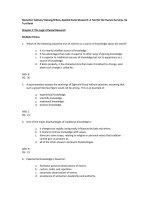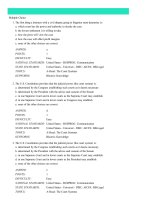Test bank for the muscular system manual the skeletal muscles of the human body 3rd edition by muscolino
Bạn đang xem bản rút gọn của tài liệu. Xem và tải ngay bản đầy đủ của tài liệu tại đây (38.36 KB, 4 trang )
buy this full document at
Muscolino: The Muscular System Manual: The Skeletal Muscles of the
Human Body, 3rd Edition
Chapter 1: Basic Kinesiology Terminology
Test Bank
MULTIPLE CHOICE
1. Which are the two major divisions of the human body?
a. upper extremities and lower extremities
b. axial body and upper extremities
c. appendicular body and extremities
d. axial body and appendicular body
ANS: D
2. In kinesiology terminology, the arm is the body part that is located between
a. the shoulder joint and the tips of the fingers.
b. the shoulder joint and the elbow joint.
c. the shoulder joint and the wrist joint.
d. the medial border of the scapula and the wrist joint.
ANS: B
3. In kinesiology terminology, the leg is the body part that is located between
a. the hip joint and the knee joint.
b. the knee joint and the ankle joint.
c. the hip joint and the ankle joint.
d. the hip joint and the tips of the toes.
ANS: B
4. What is the name of the standard reference position for describing the location of
structures and points on the human body?
a. axial position
b. functional position
c. anatomic position
d. flexion
ANS: C
5. Which term describes when a structure is located farther to the front of the body?
a. anterior
b. posterior
c. medial
d. lateral
buy this full document at
Full file at />ANS: A
6. Which term describes when a structure is located closer to the midline of the body?
a. anterior
b. posterior
c. medial
d. lateral
ANS: C
7. Which pair of terms is usually used only on the appendicular body?
a. anterior/posterior
b. medial/lateral
c. superior/inferior
d. proximal/distal
ANS: D
8. Which plane divides the body into left and right portions?
a. sagittal
b. frontal
c. transverse
d. oblique
ANS: A
9. Which plane divides the body into anterior and posterior portions?
a. sagittal
b. frontal
c. transverse
d. oblique
ANS: B
10. Which plane is horizontal?
a. sagittal
b. frontal
c. transverse
d. oblique
ANS: C
11. Which are cardinal planes?
a. sagittal and oblique
b. frontal and oblique
c. frontal and transverse
d. oblique and transverse
ANS: C
Mosby items and derived items © 2010 by Mosby, Inc., an affiliate of Elsevier Inc.
Full file at />12. What is the relationship of an axis to its plane?
a. it is parallel
b. it is located within the plane
c. it is perpendicular
d. there is no relationship
ANS: C
13. What is the axis for the sagittal plane?
a. mediolateral
b. anteroposterior
c. superoinferior
d. vertical
ANS: A
14. What is the axis for the frontal plane?
a. mediolateral
b. anteroposterior
c. superoinferior
d. vertical
ANS: B
15. Which movement term usually describes a motion that is away from the midline of the
body?
a. right rotation
b. adduction
c. flexion
d. abduction
ANS: D
16. Which movement term usually describes a motion that is posterior?
a. flexion
b. extension
c. abduction
d. pronation
ANS: B
17. Which movement term is used to describe motion of the forearm at the radioulnar joints?
a. flexion
b. abduction
c. supination
d. lateral rotation
ANS: C
Mosby items and derived items © 2010 by Mosby, Inc., an affiliate of Elsevier Inc.
Full file at />18. Which movement term describes motion of the scapula that results in the glenoid fossa
facing more superiorly?
a. upward tilt
b. protraction
c. downward rotation
d. upward rotation
ANS: D
19. Which is not a joint action?
a. flexion
b. circumduction
c. right rotation
d. dorsiflexion
ANS: B
20. Which term describes extension that occurs beyond normal or healthy range of motion?
a. circumduction
b. hypoextension
c. hyperextension
d. stability
ANS: C
21. Which movements usually occur within the frontal plane?
a. flexion/extension
b. right rotation/left rotation
c. dorsiflexion/plantarflexion
d. abduction/adduction
ANS: D
22. Which movements usually occur within the transverse plane?
a. flexion/extension
b. right rotation/left rotation
c. dorsiflexion/plantarflexion
d. abduction/adduction
ANS: B
Mosby items and derived items © 2010 by Mosby, Inc., an affiliate of Elsevier Inc.









